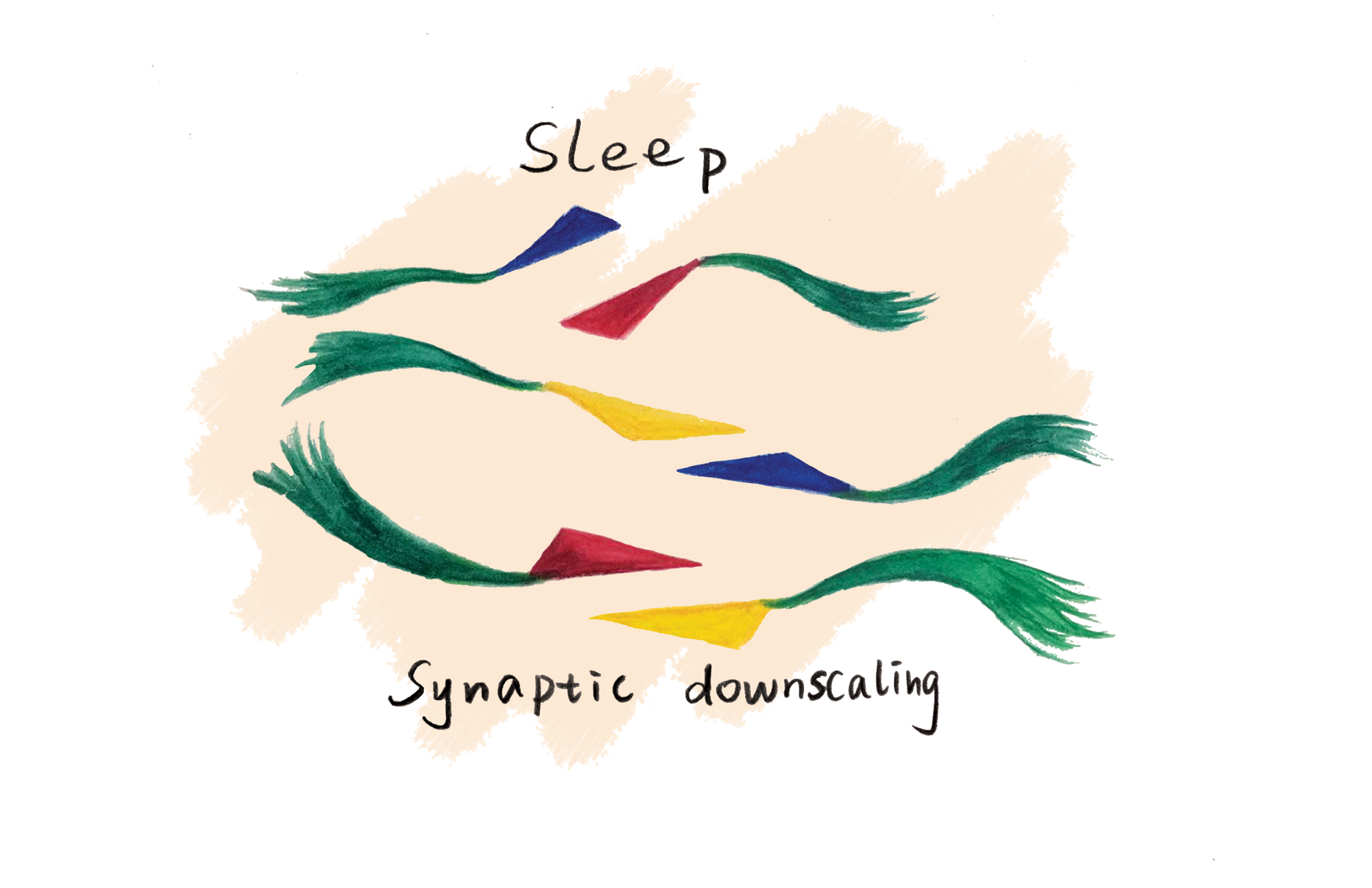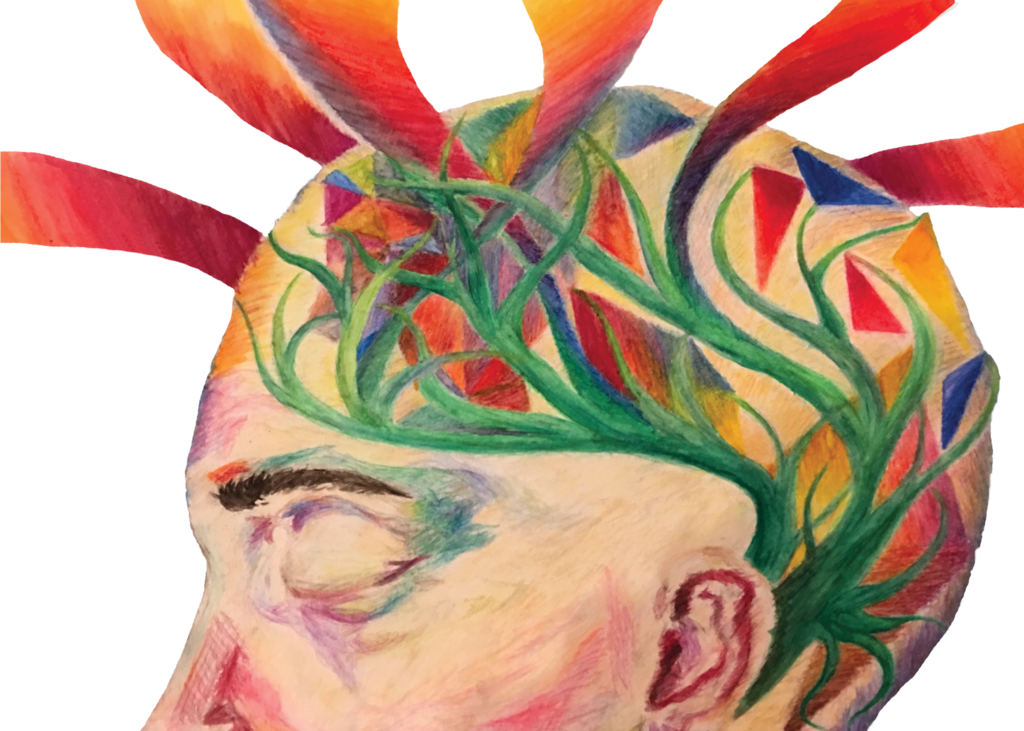Sleep sets people back. Every night, people stop and doze off; they don’t eat, work, or learn. Evolutionarily, it should be a recessive trait—after all, non-sleepers could get so much more done! Yet no creature goes without sleep, and chronic sleep loss is correlated with several detriments, like obesity, fatigue, poor mood, and ‘brain fog’ [1, 2] . On top of that, just 19 hours without sleep can cause the same amount of mental impairment as a blood alcohol content (BAC) of 0.05%, and impairment only increases with more hours spent awake. This means a late-night drive after a long day could be as dangerous as driving under the influence [3] . It is clear that people need sleep for their health and
well-being, but what makes sleep so essential?
The synaptic homeostasis hypothesis (SHY) proposes that sleep is a way of resetting the brain after daytime activity [4] . In essence, sleep serves to downscale the neural connections formed during the day, since the process of learning and forming memories saturates and exhausts the brain.Most of waketime activity excites groups of neurons to form memories. Memory formation occurs through a variety of methods, all of which depend on plasticity, the capacity of neural connections to change in strength. Plasticity may be enacted through potentiation, in which neurons become more connected at chemical synapses, or through physical changes, in which neurons grow and morph to increase contact [5] . All of these result in the strengthening of a pattern of neural firing, providing a basis for learning and memory.

Long-term potentiation (LTP), an extended strengthening of a neural connection, is attributed to long-term memory [4]. Waking conditions in the brain favor LTP through various mechanisms, such as increasing noradrenaline, an excitatory stress neurotransmitter, to cause a net increase in potentiation. By the end of the day, the brain has more connections between neurons, more firing of neurons, more neurotransmitters released, and more receptors produced. In summary, more activity across the board [4].
However, continual potentiation is unsustainable. Expansion of neural networks will eventually become inhibited by the space limitations of the brain, and the energy costs of creating and maintaining the protein and dendritic spines would be massive. In addition, the constant signaling would create ‘noise,’ as it maintains too many irrelevant connections [4]. Trying to function in these conditions would be like trying to focus while a dozen televisions blast commercials at you. This may be what causes the symptoms of sleep deprivation, since an information-bloated brain would lose the capacity to function, leading to the ‘brain fog’ and fatigue familiar to overworked people.
Sleep ameliorates the oversaturation of connections from waking hours by proportionally depressing all neural connections [4]. The net amount of connections in the brain is brought down to a sustainable baseline, allowing for further growth the next day and a reduction in energy expenditure. Since neural connections are reduced in proportion to use, weak, unused connections get pruned away. This lessens ‘noise’ by only keeping the more visited neural pathways.
The mechanism for SHY occurs during the slow wave phase of sleep, in which the electric potentials in the brain go through steady oscillations of less than 1 Hz [4]. This non-REM sleep consists of an up-phase and down-phase, characterized by high neural firing and silence, respectively. Slow wave activity (SWA) may uncouple connections by having the signal from connected neurons not occur sequentially, leading to synaptic de-potentiation. Essentially, having neurons fire together—not having the activity in one neuron lead to stimulation of the next neuron—mimics the failure of a signal to progress, instructing brain cells to reduce investments in that connection [4]. Other mechanisms in slow wave sleep also work to promote synaptic de-potentiation [4]. A drop in noradrenaline and an increase in molecules implicated in weakening synapses have been recorded in sleep. A rise in insulin during sleep motivates reduction of receptors in synapses [4].

Through these changes and SWA, neural connections are downscaled until they reach an intermediate state [6]. Downscaling is limited since the synchrony of firing drops with downscaling, essentially preventing the loss of important connections. On the other hand, weaker connections may drop below a threshold minimum for connectivity, leading to the pruning of that connection [6].
Recent studies bolster SHY with evidence. A study published in Science in early February documented proportional synaptic downscaling in mouse motor and sensory cortices [7]. Neural connections in the mice brains were further reduced in weaker synapses, maintaining strong connections while eliminating noise. The study also illuminated a mechanism for downscaling through a specific protein, Homer1a. Once Homer1a is in the synapse, it triggers a downscaling of synapses through a signaling pathway. Waking activity triggers increased expression of Homer1a; however, high levels of noradrenaline prevent the protein from entering synapses. Thus, during waking activity, Homer1a cannot reduce neural connections. Sleeping lowers noradrenaline levels, allowing Homer1a to enter the synapse and reduce neural connections. Synaptic downscaling through Homer1a may act together with memory consolidation, leading to the improvement of learning after sleep [7].
SHY has been supported by evidence of physical synaptic changes as well [8, 9]. One study recorded a decrease in potentiating factors after sleep like GluR1-containing AMPARs, which are proteins that increase synaptic strength between neurons, and LTP-associated factors like brain-derived neurotrophic factor [9]. Another study found that after sleep, mice brains displayed a great decrease in neural surface contact, the sites of signaling and connection. Large dendritic spines, which are connections strengthened through use, evaded the decrease, demonstrating selective downscaling [8]. This provides evidence for synaptic down scaling functioning to reduce synaptic ‘noise’ while maintaining important connections.
However, SHY is not comprehensive and instead coexists with many models and theories of sleep. For one, SHY focuses on slow wave sleep and does not address the events in REM sleep, which have been linked with memory consolidation. The memory consolidation view of sleep proposes that allocation of memories from short-term to long-term storage benefits from the disconnect from external stimuli [10, 11]. Other theories include the glymphatic function of sleep, in which sleep and unconsciousness trigger an increased flow of cerebrospinal fluid through the brain. Metabolites and neurotoxins generated during the day are cleared by the increased flow, reducing osmotic pressure and keeping the brain safe from those toxins [12].
The SHY model will change with further developments and become more nuanced as research continues. Certain neurons in the lateral hypothalamus do not fit the model, as they peak in activity during sleep, perhaps as a way to inhibit arousal systems [13]. Excitatory activity was investigated in a 2016 study, which indicated that slow wave sleep and SWA may excite some groups of neurons instead of inhibiting them all [14]. The study also indicated that REM sleep contributes to the decreased firing rate of neurons after sleep, demonstrating that the homeostatic processes may extend to other parts of sleep [14].
Though the SHY theory may undergo modifications, the evidence demonstrating synaptic downscaling provides support for the theory and shows that SHY might become a lasting hypothesis in sleep theory. It provides an excellent explanation for why sleep is necessary and why loss of sleep causes fatigue and cognitive impairment. Sleep research is expanding, and has a promising outlook on the development of more accurate and comprehensive sleep theories. Perhaps the future holds shy-er neurons and better sleep.
References
- Van Cauter, E., Spiegel, K., Tasali, E., & Leproult, R. (2008). Metabolic consequences of sleep and sleep loss. Sleep Medicine, 9(0 1), S23–S28. https://doi.org/10.1016/S1389-9457(08)70013-3
- Cirelli, Chiara, and Giulio Tononi. “Is Sleep Essential?” PLOS Biology 6.8 (2008): e216. PLoS Journals. Web.
- Williamson, A. M., & Feyer, A.-M. (2000). Moderate sleep deprivation produces impairments in cognitive and motor performance equivalent to legally prescribed levels of alcohol intoxication. Occupational and Environmental Medicine, 57(10), 649–655. https://doi.org/10.1136/oem.57.10.649
- Tononi, G., & Cirelli, C. (2006). Sleep function and synaptic homeostasis. Sleep Medicine Reviews, 10(1), 49–62. https://doi.org/10.1016/j.smrv.2005.05.002 https://www.ncbi.nlm.nih.gov/pmc/articles/PMC3880190/
- Kasai, H., Fukuda, M., Watanabe, S., Hayashi-Takagi, A., & Noguchi, J. (2010). Structural dynamics of dendritic spines in memory and cognition. Trends in Neurosciences, 33(3), 121–129. https://doi.org/10.1016/j.tins.2010.01.001
- Tononi, G., & Cirelli, C. (2014). Sleep and the Price of Plasticity: From Synaptic and Cellular Homeostasis to Memory Consolidation and Integration. Neuron, 81(1), 12–34. https://doi.org/10.1016/j.neuron.2013.12.025
- Diering, G. H., Nirujogi, R. S., Roth, R. H., Worley, P. F., Pandey, A., & Huganir, R. L. (2017). Homer1a drives homeostatic scaling-down of excitatory synapses during sleep. Science, 355(6324), 511–515. https://doi.org/10.1126/science.aai8355
- Vivo, L. de, Bellesi, M., Marshall, W., Bushong, E. A., Ellisman, M. H., Tononi, G., & Cirelli, C. (2017). Ultrastructural evidence for synaptic scaling across the wake/sleep cycle. Science, 355(6324), 507–510. https://doi.org/10.1126/science.aah5982
- Vyazovskiy, V. V., Cirelli, C., Pfister-Genskow, M., Faraguna, U., & Tononi, G. (2008). Molecular and electrophysiological evidence for net synaptic potentiation in wake and depression in sleep. Nature Neuroscience, 11(2), 200–208. https://doi.org/10.1038/nn2035
- Rasch, B., & Born, J. (2013). About Sleep’s Role in Memory. Physiological Reviews, 93(2), 681–766. https://doi.org/10.1152/physrev.00032.2012
- Xie, L., Kang, H., Xu, Q., Chen, M. J., Liao, Y., Thiyagarajan, M., ... Nedergaard, M. (2013). Sleep Drives Metabolite Clearance from the Adult Brain. Science (New York, N.Y.), 342(6156). https://doi.org/10.1126/science.1241224
- Stickgold, R., & Walker, M. P. (2007). Sleep-Dependent Memory Consolidation and Reconsolidation. Sleep Medicine, 8(4), 331–343. https://doi.org/10.1016/j.sleep.2007.03.011
- Hassani, O. K., Henny, P., Lee, M. G., & Jones, B. E. (2010). GABAergic neurons intermingled with orexin and MCH neurons in the lateral hypothalamus discharge maximally during sleep. The European Journal of Neuroscience, 32(3), 448–457. https://doi.org/10.1111/j.1460-9568.2010.07295.x
- 14. Watson, B. O., Levenstein, D., Greene, J. P., Gelinas, J. N., & Buzsáki, G. (2016). Network Homeostasis and State Dynamics of Neocortical Sleep. Neuron, 90(4), 839–852. https://doi.org/10.1016/j.neuron.2016.03.036
